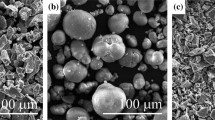Abstract
Open-porous titanium scaffolds have been widely investigated for orthopaedic and dental applications because of their ability to form composites via bone ingrowth into pores and promote implant fixation with mother bone. In this work, porous titanium scaffolds coated with a diamond-like carbon were produced, and their ability to form biocomposites was evaluated through in vivo experiments. Three types of the open-porous scaffolds made of spongy titanium granules (porosity 0.3, 0.4 and 0.5, Young’s modulus 4.4, 3.5 and 0.6 GPa) were implanted into a bone defect of sheep. Time dependences of the Young’s modulus of titanium scaffold–bone tissue biocomposites were determined through the measurement of Young’s modulus of the extracted scaffolds after 4, 8, 24 and 52 weeks of surgery. The Young’s modulus of biocomposite is dependent not only on the time of composite formation but also on the porosity of scaffold.



Similar content being viewed by others
References
Geetha M, Singh A K, Asokamani R and Gogia A K 2009 Prog. Mater. Sci. 54 397
Cachinho S C P and Correia R N 2008 J. Mater. Sci. Mater. Med. 19 451
Lewis G 2013 J. Mater. Sci. Mater. Med. 24 2293
Bandyopadhyay A, Espana F, Krishna Balla V, Bose S, Ohgami Y and Davies N N 2010 Acta Biomater. 6 1640
Ryan G, Pandi A and Apatsidis D P 2006 Biomaterials 27 2651
Zhao C Y, Zhu X D and Yuan T 2010 Mater. Sci. Eng. C 30 98
Martin R B, Chapman M W, Sharkey N A, Zissimos S L, Bay B and Shors E C 1993 Biomaterials 14 341
Rubshtein A P, Makarova E B, Rinkevich A B, Medvedeva D S, Yakovenkova L I and Vladimirov A B 2015 Mater. Sci. Eng. C 52 54
Trakhtenberg I S, Borisov A B, Novozhonov V I, Rubshtein A P, Vladimirov A B, Osipenko A V et al 2008 Phys. Met. Metallogr. 105 92
Jaatinen J, Korhonen R, Pelttari A, Helminen H, Korhonen H and Lappalainen R 2011 Acta Orthop. 82 499
Fox K, Palamara J, Judge R and Greentree A D 2013 J. Mater. Sci. Mater. Med. 24 849
Rubstein A P, Makarova E B, Trakhtenberg I S, Kudryavtseva I P, Bliznets D G, Philippov Y I et al 2012 Diam. Relat. Mater. 22 128
Reichert J C, Cipitria A, Epari D R, Saifzadeh S, Krishnakanth P and Berner A 2012 Sci. Transl. Med. 4 14193
Efros A L 1982 Physics and geometry of disorder (Moscow: Nauka)
Odgaard A and Linde F 1991 J. Biomech. 24 691
Acknowledgements
This research was carried out within the state assignment of FASO of Russia (theme ‘Spin’ No. 01201463330), supported in part by RFBR (Project No. 13-02-96031).
Author information
Authors and Affiliations
Corresponding author
Rights and permissions
About this article
Cite this article
Rubshtein, A.P., Makarova, E.B., Bliznets, D.G. et al. Properties of biocomposites based on titanium scaffolds with a different porosity. Bull Mater Sci 40, 453–457 (2017). https://doi.org/10.1007/s12034-017-1394-0
Received:
Accepted:
Published:
Issue Date:
DOI: https://doi.org/10.1007/s12034-017-1394-0




